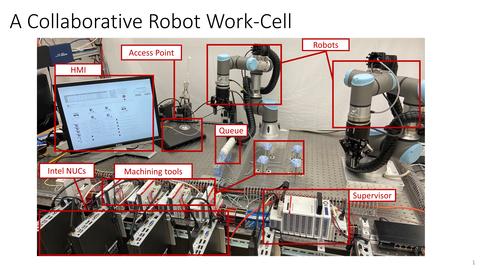Summary
Smart Manufacturing Systems provide a vision of future manufacturing systems that incorporate highly dynamic physical systems, robust and responsive communications systems, and computing paradigms to maximize efficiency, enable mobility, promote flexibility, and realize the promises of the digital factory. Wireless technology is a key enabler of this vision. Key challenges to integrating wireless systems within the factory environment include identifying robust requirements for wireless networks; managing coexistence of a variety of networks within a finite electromagnetic spectrum; realizing spectrum-aware and power-aware distributed control systems, achieving high-reliability and low-latency; integrating spectrum awareness within the automation system; exploring co-design methodologies for control systems that are aware of the state of the underlying communications system; and defining repeatable testing and metrology methods for assessing performance. This project addresses these challenges by developing robust system requirements, system models, recommended architectures, metrology approaches for industrial wireless systems, test methods standardization, and guidelines for establishing trustworthy wireless systems within the agile and collaborative factory environment.
Description

Through collaboration with industry and academia, we will continue to develop model architectures for high-priority industrial use cases that include mobile robotic and collaborative platforms. We will continue to select use cases based on industry input and our independent research. In this project we will:
- Establish a standards working group within the IEEE for the development of a universal reference environment model for performance testing of wireless systems in industrial environments. The reference model will focus primarily on channel aggressors such as interference, competing network traffic, jamming, and multi-path. A consensus was reached at the NIST Industrial Wireless Workshop in June 2021 that such a reference model would be essential to many industries and could have far reaching impacts.
- Investigate, with industry, metrology approaches for the performance evaluation of industrial wireless systems; and implement demonstrations or prototypes of evaluation methods depending on the progress of the standardization effort listed prior.
- Assess the performance of a collaborative robotic and other factory processes within the NIST Industrial Wireless Systems (IWS) Testbed in collaboration with Intel Labs using 802.11ac/ax with time sensitive networking (TSN). Channel aggressors are implemented within the testbed to evaluate performance under various conditions.
- Implement a wireless-based safety integrated system for a normally-closed safety circuit for evaluation of safety system performance when various wireless communication protocols are used. Channel aggressors are implemented within the lab to evaluate performance under various conditions.
- Engage industry through the NIST Industrial Wireless Technical Working Group (IWSTWG) which is an ad-hoc NIST-organized interest group for the application of wireless technologies to industrial systems. The IWSTWG includes more than 80 individuals from around the world ranging from small to large businesses, standards organizations, laboratories, and universities.
Major Accomplishments
Candell, R. , Montgomery, K. , Hany, M. , Sudhakaran, S. , Albrecht, J. and Cavalcanti, D. (2022), Operational Impacts of IEEE 802.1Qbv Scheduling on a Collaborative Robotic Scenario, 48th Annual Conference of the Industrial Electronics Society IECON 2022 Conference, Brussels, BE, [online], https://tsapps.nist.gov/publication/get_pdf.cfm?pub_id=935097
Candell, R. , Hany, M. , Perez-Ramirez, J. and Conchas, J. (2022), An IEEE Standard for the Evaluation of Wireless Networks for Industrial Automation, IEEE Internet of Things Magazine, [online], https://tsapps.nist.gov/publication/get_pdf.cfm?pub_id=934487
Candell, R. , Hany, M. , Lee, K. , Liu, Y. , Quimby, J. and Remley, C. (2018), Guide to Industrial Wireless Systems Deployments, Advanced Manufacturing Series (NIST AMS), National Institute of Standards and Technology, Gaithersburg, MD, [online], https://doi.org/10.6028/NIST.AMS.300-4
Montgomery, K. , Candell, R. , Liu, Y. and Hany, M. (2019), Wireless User Requirements for the Factory Workcell, Advanced Manufacturing Series (NIST AMS), National Institute of Standards and Technology, Gaithersburg, MD, [online], https://doi.org/10.6028/NIST.AMS.300-8
Candell, R., Kashef, M., Montgomery, K., Liu, Y., & Foufou, S. (2022). Machine Learning Based Wireless Interference Estimation in a Robotic Force-Seeking Application. https://doi.org/10.6028/NIST.IR.8416
Kashef, M., Liu, Y., Montgomery, K., & Candell, R. (2021). Wireless Cyber-Physical Systems Performance Evaluation through a Graph Database Approach. Journal of computing and information science in engineering, 21(2), 10.1115/1.4048205. https://doi.org/10.1115/1.4048205.
R. Candell, K. Montgomery, S. Sudhakaran, M. Kashef, and D. Cavalcanti. Impacts of 802.1Qbv Time-sensitive Networking Schedules on the Physical Performance of a Leader-Follower Robot Lift Operation. Proceedings of the IEEE Industrial Electronics Conference 2023. In process.

